Simple Determination of Haloacetic Acids (HAA) by Detection of Ion Chromatography (IC) and Mass Spectrometry (MS)
Introduction
Haloacetic acids (HAAs) are generally released as disinfection by-products of water treatment processes. Some HAAs are monitored as a part of regulations and they are classified as potentially carcinogenic.
Traditionally, HAAs are analyzed by gas chromatography (GC), a technique that requires time-consuming sample extraction and derivatization and lead to higher operating costs per analysis.
Mass spectrometry (e.g., single, or triple quadrupole MS systems) combined with Ion Chromatography (IC) is a powerful tool that can perform many analytical tasks, such as performing HAA determinations at μg/L levels in drinking water samples.
After the components in the sample are separated via IC, the mass selective detection technique ensures to determine and identify analytes, including low concentration limits.
The incorporation of automatic
Metrohm Inline Sample Preparation (MISP) techniques into the IC systems, various sample types can be easily analyzed without the need to extensive and manual laboratory work.
Besides the analysis, automation of sample preparation steps ensures obtaining more reliable and reproducible data. This research article aims to explain the intricacies of the IC-MS technique as well as its benefits for the accurate and precise measurement of HAAs in water samples.
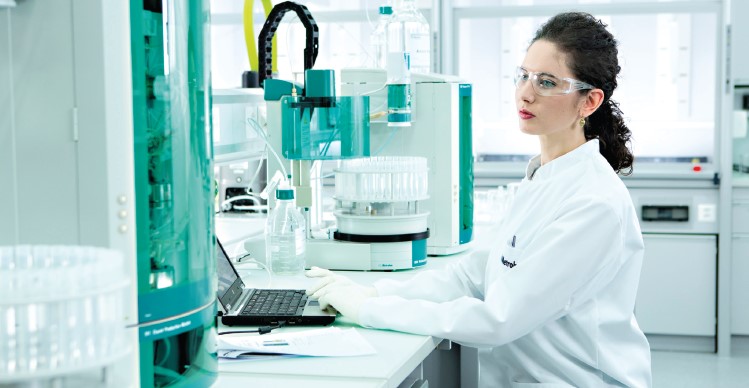
Overview of Combined MS Technique with IC
Ion Chromatography typically overcomes difficult separation problems using the interactions between ionic species in liquid samples and a stationary separation column, utilizing conductivity detection.
Mass detection accomplished with a mass spectrometer as a secondary independent detector (e.g., MS, MS/MS) for IC records the mass-to-charge ratios (m/z) of selected analytes of interest. As such, mass detection confirms the identity of compounds present in
challenging matrices to ensure that the correct results are obtained without question.
Coeluting components can be quantified, and detection limits are considerably improved.
High-performance liquid chromatography mass spectrometry (HPLC-MS) is a well-established analysis technique. However, separation of ionic compounds is difficult with this conventional HPLC-MS technique.
With the use of the IC-MS combination, this difficulty can be easily overcome. For these analytes, the IC-MS technique is applied as a successful method with specific columns that are optimized for ion separation.
The suppressor units within the IC system minimizes the ion load from the eluent to optimize signal-to-noise ratios for both conductivity and MS detection. In Metrohm IC systems, sequential suppressor systems (chemical and carbon dioxide suppression) which positioned after the separation column and before the detector, are used and an unconditional 10 year warranty is offered especially for anion chemical suppressor units.
IC-MS is a robust and easy-to-use technique for the determination of analytes such as inorganic anions, organic acids, HAAs, oxyhalides, alkali and alkaline earth metals. By adding Metrohm Inline Sample Preparation (MISP) techniques to the system configuration, it is possible not only to easily analyze water samples, but also chemicals, organic solvents, or post-explosion residues.
[caption id="attachment_145334" align="aligncenter" width="579"]
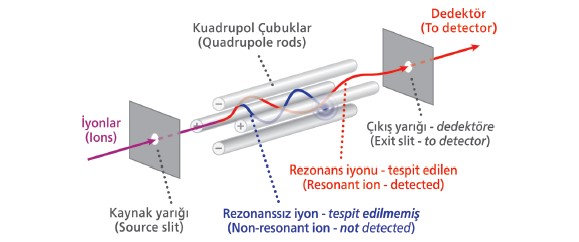
Figure 1. Schematic representation of the working principle of single quadrupole MS.[/caption]
Mass Detection for Small Ionic Compounds
With IC, many analytes are detected via conductivity techniques, nonetheless, other common detectors such as UV/VIS or amperometric detection can also be used.
Identification of the analytes is done by comparing the retention times of the peaks detected in the chromatogram with those prepared standard solutions. This comparison
can be challenging for samples with multiple components or where there are extreme concentration differences between the sample matrix and the analyte.
A mass detector connected in series with the conductivity detector correlates the conductivity signal with the corresponding mass-to-charge signal, ensuring low detection
limits and accurate peak identification. Combining the IC with a mass detector, significantly expands the application fields for such hybrid systems.
Molecular ions are typically analyzed using single quadrupole mass spectrometers (Figure 1). High-end mass spectrometers such as triple quadrupoles have even greater sensitivity and can elucidate structural details with fragmentation studies.
Combination of IC and MS Hardware
Metrohm IC systems can be coupled to many different MS devices (Figure 2), available from any supplier. The synchronization of both instruments typically utilizes a remote box and a suitable cable connection to notify the MS detector to start recording once the sample is injected.
Regarding the hardware connection, a simple capillary connection between the conductivity detector and the MS detector is sufficient. The conductivity detector is a non-destructive detector with a low dead volume (>1 μL) and its outlet capillary (a PEEK capillary with 0.25
mm ID) is typically connected to either the injection valve of the MS, or directly to its source inlet.
[caption id="attachment_145335" align="aligncenter" width="661"]

Figure 2. Synchronization of Metrohm IC devices with MS devices from any supplier is possible.[/caption]
Further addition of extra components to the systems is possible to improve the applications. A splitter can optimize the sample flow rate that reaches the MS for optimal signal-to-noise ratio. A switch valve can be used to channel the flow into the MS only when
elution of analytes of interest is expected.
The flow is diverted to the waste when matrix peaks elute, during instrument equilibration, and automatic sample preparation, in order to keep contamination of the MS to a minimum.
Some applications may require the addition of reagent (e.g., organic solvent) via postcolumn derivatization (PCR) prior to MS analysis or even may require an additional suppressor module to adjust pH or remove matrix ions to avoid signal suppression.
General Approach for All MS Types
If there is no common software to operate both systems, the devices are run through their own software. In such cases, sample tables need to be copied to both software, and data evaluation is typically done in the software of the respective device (e.g., processing of
conductivity signal in IC software and m/z signals in MS software). This approach is often used for highend MS analysis with dedicated MS software.
For instance, Metrohm IC systems can be operated with MagIC Net software, while the MS detector can be controlled by software from manufactures such as Agilent (MassHunter™), Waters (MassLynx™) or AB Sciex (Analyst®).
These flexible and high-performance configurations unleash their full potential in development laboratories and research institutes. On the other hand, operation of such configurations brings the need for trained personnel, hence it can be difficult for analysts to work under full compliance since the complete system is controlled by two independent
software.
IC Drivers for One Common Software
Native Metrohm IC drivers enable IC systems to be controlled and operated within the same software as MS detectors, including autosamplers and high sensitivity burettes such as Metrohm Dosino devices.
Single software for both IC and MS systems, facilitates user-friendly application and robust operation. Through single software, the training processes are faster and easier, while data integrity and full compatibility are guaranteed with these drivers.
Metrohm can offer common solutions through Metrohm IC drivers for Waters Empower™ 3 and Agilent OpenLab CDS software.
Analysis of Haloacetic Acids in Water Samples according to US EPA Method 557 with IC-MS Detection Technique
Chlorine in various forms remains the primary disinfection method for municipal water systems. Chlorine can form μg/L levels of disinfection byproducts (DBP’s) in water supplies, which include haloacetic acids (HAA’s).
While there is no conclusive evidence of continued exposure to high concentrations of these
HAAs yet, they are thought to pose potential cancer risks. Various global organizations, including the US Environmental Protection Agency (EPA), have defined a threshold value for the maximum HAA content in municipal water as a health precaution.
Recently, the European Parliament revised the “Drinking Water Directive”, defining the total limit of nine HAAs as 60 μg/L. Therefore, interest in measuring the concentration of trace amounts of HAAs in municipal water system sources has increased significantly.
Achieve the Lowest Detection Limits with IC and MS
To address the need to measure various HAAs at μg/L levels in municipal water samples, a robust method has been developed using the IC-MS/MS detection technique, which complies with US EPA Method 557.
Within this method, the major benefit of using MS/ MS with a triple quadrupole mass spectrometer over using MS with a single quadrupole mass spectrometer is the ability to avoid potential interferences while achieving lower detection limits and enhanced selectivity.
Other analytical methods require complex and labor-intensive sample derivatization processes to detect analytes. In the developed IC-MS/MS method, known amounts of internal standards are spiked to water samples and the samples are directly analyzed
without any required derivatization, cleaning, or preconcentration steps.
By this method, a significant amount of time is saved per sample, increasing the analysis efficiency, and reducing operating costs. Another advantage of using a Metrohm IC system for this task is that it allows organic solvent to be added directly to the eluent, enhancing not only the desolvation of analytes at the electrospray ionization (ESI) interface but also improves chromatographic separation.
Within the method followed in this research article, analyses were performed with IC-MS/MS system, using a Metrohm IC connected to an Agilent 6470 triple quadrupole MS for the detection of nine HAAs, dalapon and bromate ions (Table 1).
These compounds were separated on the Metrosep A Supp 7 - 250/4.0 separation column using a dual channel gradient system. The analytes examined in the method and their technical parameters are shown in Table 2.
After the suppression, the analytes were transferred to the MS, and selected MRM (multiple reaction monitoring) transitions were used for quantification (Figure 3).
[caption id="attachment_145336" align="aligncenter" width="407"]
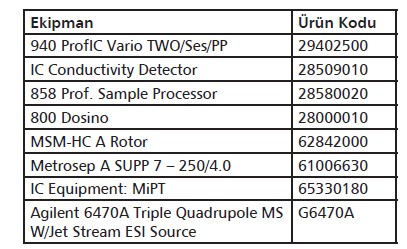
Table 1. IC-MS system components[/caption]
[caption id="attachment_145337" align="aligncenter" width="388"]

Table 2. Retention times and MS/MS acquisition parameters for nine HAAs, dalapon, and bromate.[/caption]
[caption id="attachment_145338" align="aligncenter" width="822"]
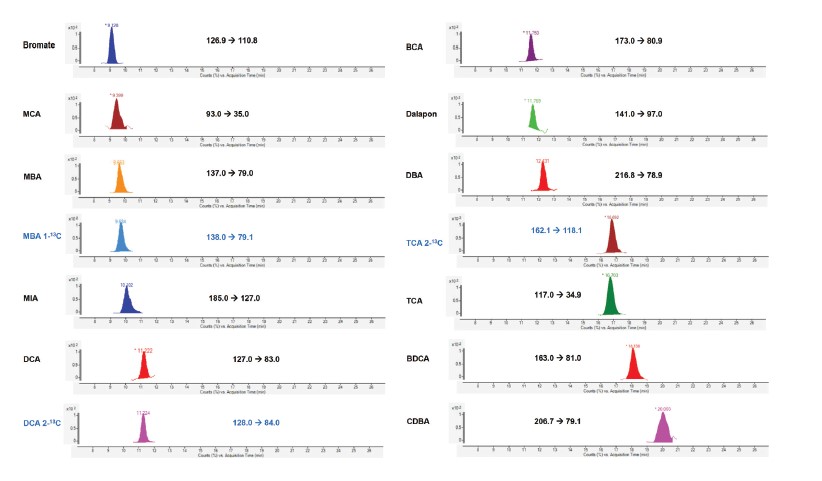
Figure 3. Mixed analytes of 50 μg/L each and internal standards of 100 μg/L were separated using the Metrosep
A Supp 7 - 250/4.0 column. Analytes are labeled in black and internal standards are labeled in blue.[/caption]
The chemical calibration for this study covers a concentration range of 1–500 μg/L with linear regression. MagIC Net was used as the chromatographic software, and the Agilent Mass Hunter™ software was used to operate the MS. The reagents used in these analyses are listed in Table 3, the IC and MS parameters are listed in Tables 4-1 and 4-2.
IC Reagents
[caption id="attachment_145606" align="aligncenter" width="386"]

Table 3. The reagents used for HAA analysis.[/caption]
IC Parameters
[caption id="attachment_145605" align="aligncenter" width="386"]

Table 4-1. IC system parameters.[/caption]
Parameters MS/MS (Triple Quadrupole)
[caption id="attachment_145604" align="aligncenter" width="383"]

Table 4-2. MS system parameters.[/caption]
To tune and optimize the MS, an additional Dosino was used to supply a steady flow of analyte solution (0.2 mg/L) directly into the ESI source at a rate of 0.5 mL/min. In this way, the MS source settings could be optimized for each analyte in an automated way without chromatographic separation.
During the first 7 minutes after injection and between 27 and 28.5 minutes, the eluent flow is directed to waste. This diversion prevents the detection of unretained compounds or non-target compounds, and minimizes contamination of the MS source, thus reducing the need for frequency of MS source cleaning.
The performance of the developed method was demonstrated by spiking known amounts of analytes to water samples and measuring their recoveries (Table 5).
[caption id="attachment_145607" align="aligncenter" width="381"]

Table 5. Municipal water sample spiked with 25 μg/L of each listed analyte and the results of the analyzes performed in five replicates.[/caption]
In addition to these studies, municipal water samples of the Tampa Bay area (Florida, USA) were also analyzed for HAA content. These samples contained less than 60 μg/L of total HAA, which is the critical limit according to US EPA guidelines (Table 6).
[caption id="attachment_145608" align="aligncenter" width="382"]
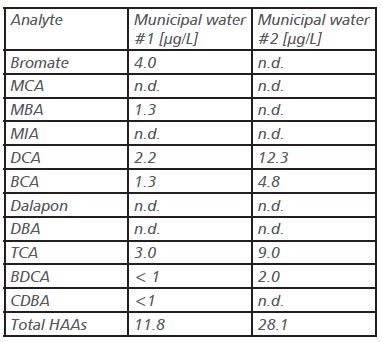
Table 6. HAA results in two different municipal water samples.[/caption]
Analysis of HAAs in Water Samples with IC and Different Brand MS Detector
The same application work was performed with the instrument combination of Metrohm IC and AB Sciex QTRAP 6500+ devices. Chromatographic separation was achieved under the same conditions as in the previous application (Figure 3), and the analysis parameters
for MS detection were adapted to this instrument.
Bromate, dalapon and ten HAA compounds were detected in the range of 0.2 μg/L, and even 0.02 μg/L to 200 μg/L, depending on the analyte involved. In this configuration,
chromatographic separation was performed using AB Sciex Analyst® software (Figure 4).
Monofluoroacetic acid (MFA), difluoroacetic acid (DFA), monoiodoacetic acid (MIA) and trifluoroacetic acid (TFA) were additionally investigated in the water samples, but their amounts could not be determined.
The accuracy of this method and its robustness against matrix effects have been proven by spike tests performed on tap water (Figure 5) and bottled water (Figure 6) samples.
[caption id="attachment_145344" align="aligncenter" width="829"]
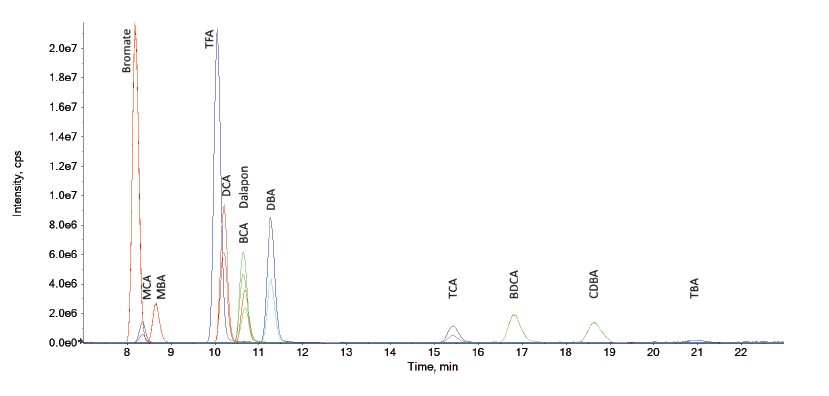
Figure 4. Ten HAA compounds (including TFA and TBA), bromate and dalapon ions (200 μg/L of each analyte,
100 µL injection volume) were separated on the Metrosep A Supp 7 - 250/4.0 column.[/caption]
[caption id="attachment_145345" align="aligncenter" width="819"]

Figure 5. Illustration of sample chromatograms for TCA (A) and BDCA (B) spiked at 2 μg/L to tap water samples.[/caption]
[caption id="attachment_145346" align="aligncenter" width="449"]
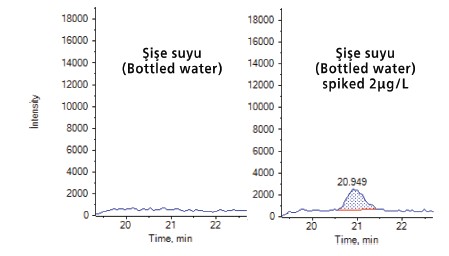
Figure 6. Sample chromatograms for 2 μg/L tribromoacetic acid (TBA) spiked into bottled water samples.[/caption]
As a result of the applications, it has been seen that sensitive and accurate analyses can be performed in different water samples by connecting a Metrohm IC system to an MS detector obtained from any supplier.
Combination of IC and Single Quadrupole MS Detector: Robust and Easy to Use
The current ISO norm (ISO 23631:2006) recommends using the GC-MS technique for measuring six haloacetic acids in water samples. An upcoming drinking water directive draft may indicate the use of other analytical techniques (e.g., IC-MS or IC-MS/MS) for the
purpose of measuring nine haloacetic acids with concentrations that must not exceed 5 μg/L individually, and their combined concentration must not exceed 60 μg/L.
As part of an interlaboratory study for method development, combining Metrohm IC with a single quadrupole MS (Waters SQ Detector 2) proved to be a suitable system configuration for the determination of HAAs in water samples (Table 7).
Controlling the entire configuration with Empower™ 3 software has made the application compliant and easy to perform for any operator. Nine HAAs detected in different water matrices were analyzed in 35 minutes using Metrosep A Supp 5 - 250/2.0 column and Metrosep A Supp 10/4.0 guard column.
The 2 mm microbore separation column is particularly suitable for MS detection due to the lower flow rates it requires. The ideal eluent flow rate of this separation column is 0.2 mL/min, which is perfect for MS detection.
The additional guard column improves the separation between MCA, MBA, and chloride.
Furthermore, lowering the column temperature to 10°C improved the separation between analytes. After suppression, the conductivity signal and selected ion recordings were collected.
The corresponding 13C standards were used to avoid any matrix effects for accurate quantification. With this configuration, it is possible to detect HAAs at a concentration of 5 μg/L or less in all sample matrices tested (Figure7-8).
[caption id="attachment_145609" align="aligncenter" width="384"]

Table 7. Estimated limit of quantification (LOQ) of several HAAs in ultrapure water (from S/N = 10 extrapolation).[/caption]
[caption id="attachment_145348" align="aligncenter" width="428"]
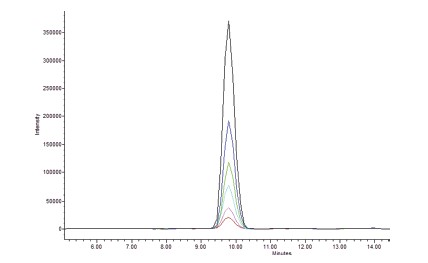
Figure 7. Example chromatograms of the MCA (m/z 93; spike concentrations 5, 10, 20, 30, 50 and 100 μg/L) ion, which is in drinking water samples,
separated with the Metrosep A Supp 5 - 250/2.0 column is shown.[/caption]
[caption id="attachment_145349" align="aligncenter" width="404"]
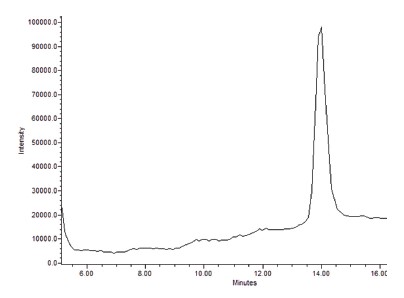
Figure 8. Example chromatogram of DBA (m/z 217; 25 μg/L) ion separated with Metrosep A Supp 5 – 250/2.0 column is shown (Analysis parameters: injection volume 100 μL, mobile phase/gradient: potassium hydroxide /sodium carbonate/acetonitrile, flow rate is 0.2 mL/min, column oven: 10°C.) Empower™ 3 software was used.[/caption]
A similar approach was accomplished when using a single quadrupole MS detector from Agilent. In this case, LCMRL (lowest concentration minimum reporting level) values of less than 0.4 μg/L were achieved for six HAAs. At the time of the study, two different software were used, one for chromatography and one for mass spectrometry.
Today, Agilent OpenLab CDSbased single software solution for Metrohm IC and MS (with Metrohm IC driver) guarantees ease of use and full traceability for all devices.
General Result
Ion chromatography is a powerful analytical tool that could be used in the laboratory, particularly for challenging sample matrices containing multiple analytes of varying concentrations.
For this reason, the unique combination of IC with MS is becoming increasingly popular for applications involving ionic and polar molecules. The determination of haloacetic acids in potable water is important to ensure the safety of the water supply and therefore the health of the population.
Metrohm IC is the ideal analytical solution for the separation of HAAs at low concentrations (μg/L) when it comes to analyzing these components. With the ability to combine with any MS detector, a variety of separation column options, and many automated Metrohm Inline Sample Preparation (MISP) techniques, trace level analysis has never been easier with our robust ion chromatography systems.
References
1. Metrohm White Paper WP-066EN 4868833 4886948 “An introduction to ion chromatography mass spectrometry (IC-MS)”
2. Metrohm White Paper WP-075EN 5034328 5034328 “Simple determination of haloacetic acids (HAAs) in potable water with ion chromatography hyphenated to mass spectrometry”
3. Metrohm Application Work AWUS6-0255-052019 “Trace Level Haloacetic Acid (HAA), Dalapon, and Bromate Analysis in Water Using a Metrohm Ion Chromatograph and an Agilent Triple Quadrupole Mass Spectrometer (IC-MS/MS) Conforming to USEPA Method
557”
4. Metrohm Application Note AN-M-15 “Trace haloacetic acids, dalapon, and bromate in water”
5. Metrohm Application Note AN-M-16 “Resolving haloacetic acids in water”
6. Triple Quadrupole Mass Spectrometer (IC-MS/MS) Conforming to USEPA Method 557”
Elif Metin Kulaksız
Senior Application Specialist
Ion Chromatography
Metrohm Turkey


 Figure 1. Schematic representation of the working principle of single quadrupole MS.[/caption]
Figure 1. Schematic representation of the working principle of single quadrupole MS.[/caption]
 Figure 2. Synchronization of Metrohm IC devices with MS devices from any supplier is possible.[/caption]
Further addition of extra components to the systems is possible to improve the applications. A splitter can optimize the sample flow rate that reaches the MS for optimal signal-to-noise ratio. A switch valve can be used to channel the flow into the MS only when
elution of analytes of interest is expected.
The flow is diverted to the waste when matrix peaks elute, during instrument equilibration, and automatic sample preparation, in order to keep contamination of the MS to a minimum.
Some applications may require the addition of reagent (e.g., organic solvent) via postcolumn derivatization (PCR) prior to MS analysis or even may require an additional suppressor module to adjust pH or remove matrix ions to avoid signal suppression.
Figure 2. Synchronization of Metrohm IC devices with MS devices from any supplier is possible.[/caption]
Further addition of extra components to the systems is possible to improve the applications. A splitter can optimize the sample flow rate that reaches the MS for optimal signal-to-noise ratio. A switch valve can be used to channel the flow into the MS only when
elution of analytes of interest is expected.
The flow is diverted to the waste when matrix peaks elute, during instrument equilibration, and automatic sample preparation, in order to keep contamination of the MS to a minimum.
Some applications may require the addition of reagent (e.g., organic solvent) via postcolumn derivatization (PCR) prior to MS analysis or even may require an additional suppressor module to adjust pH or remove matrix ions to avoid signal suppression.
 Table 1. IC-MS system components[/caption]
[caption id="attachment_145337" align="aligncenter" width="388"]
Table 1. IC-MS system components[/caption]
[caption id="attachment_145337" align="aligncenter" width="388"] Table 2. Retention times and MS/MS acquisition parameters for nine HAAs, dalapon, and bromate.[/caption]
[caption id="attachment_145338" align="aligncenter" width="822"]
Table 2. Retention times and MS/MS acquisition parameters for nine HAAs, dalapon, and bromate.[/caption]
[caption id="attachment_145338" align="aligncenter" width="822"] Figure 3. Mixed analytes of 50 μg/L each and internal standards of 100 μg/L were separated using the Metrosep
Figure 3. Mixed analytes of 50 μg/L each and internal standards of 100 μg/L were separated using the Metrosep Table 3. The reagents used for HAA analysis.[/caption]
Table 3. The reagents used for HAA analysis.[/caption]
 Table 4-1. IC system parameters.[/caption]
Table 4-1. IC system parameters.[/caption]
 Table 4-2. MS system parameters.[/caption]
To tune and optimize the MS, an additional Dosino was used to supply a steady flow of analyte solution (0.2 mg/L) directly into the ESI source at a rate of 0.5 mL/min. In this way, the MS source settings could be optimized for each analyte in an automated way without chromatographic separation.
During the first 7 minutes after injection and between 27 and 28.5 minutes, the eluent flow is directed to waste. This diversion prevents the detection of unretained compounds or non-target compounds, and minimizes contamination of the MS source, thus reducing the need for frequency of MS source cleaning.
The performance of the developed method was demonstrated by spiking known amounts of analytes to water samples and measuring their recoveries (Table 5).
[caption id="attachment_145607" align="aligncenter" width="381"]
Table 4-2. MS system parameters.[/caption]
To tune and optimize the MS, an additional Dosino was used to supply a steady flow of analyte solution (0.2 mg/L) directly into the ESI source at a rate of 0.5 mL/min. In this way, the MS source settings could be optimized for each analyte in an automated way without chromatographic separation.
During the first 7 minutes after injection and between 27 and 28.5 minutes, the eluent flow is directed to waste. This diversion prevents the detection of unretained compounds or non-target compounds, and minimizes contamination of the MS source, thus reducing the need for frequency of MS source cleaning.
The performance of the developed method was demonstrated by spiking known amounts of analytes to water samples and measuring their recoveries (Table 5).
[caption id="attachment_145607" align="aligncenter" width="381"] Table 5. Municipal water sample spiked with 25 μg/L of each listed analyte and the results of the analyzes performed in five replicates.[/caption]
In addition to these studies, municipal water samples of the Tampa Bay area (Florida, USA) were also analyzed for HAA content. These samples contained less than 60 μg/L of total HAA, which is the critical limit according to US EPA guidelines (Table 6).
[caption id="attachment_145608" align="aligncenter" width="382"]
Table 5. Municipal water sample spiked with 25 μg/L of each listed analyte and the results of the analyzes performed in five replicates.[/caption]
In addition to these studies, municipal water samples of the Tampa Bay area (Florida, USA) were also analyzed for HAA content. These samples contained less than 60 μg/L of total HAA, which is the critical limit according to US EPA guidelines (Table 6).
[caption id="attachment_145608" align="aligncenter" width="382"] Table 6. HAA results in two different municipal water samples.[/caption]
Analysis of HAAs in Water Samples with IC and Different Brand MS Detector
The same application work was performed with the instrument combination of Metrohm IC and AB Sciex QTRAP 6500+ devices. Chromatographic separation was achieved under the same conditions as in the previous application (Figure 3), and the analysis parameters
for MS detection were adapted to this instrument.
Bromate, dalapon and ten HAA compounds were detected in the range of 0.2 μg/L, and even 0.02 μg/L to 200 μg/L, depending on the analyte involved. In this configuration,
chromatographic separation was performed using AB Sciex Analyst® software (Figure 4).
Monofluoroacetic acid (MFA), difluoroacetic acid (DFA), monoiodoacetic acid (MIA) and trifluoroacetic acid (TFA) were additionally investigated in the water samples, but their amounts could not be determined.
The accuracy of this method and its robustness against matrix effects have been proven by spike tests performed on tap water (Figure 5) and bottled water (Figure 6) samples.
[caption id="attachment_145344" align="aligncenter" width="829"]
Table 6. HAA results in two different municipal water samples.[/caption]
Analysis of HAAs in Water Samples with IC and Different Brand MS Detector
The same application work was performed with the instrument combination of Metrohm IC and AB Sciex QTRAP 6500+ devices. Chromatographic separation was achieved under the same conditions as in the previous application (Figure 3), and the analysis parameters
for MS detection were adapted to this instrument.
Bromate, dalapon and ten HAA compounds were detected in the range of 0.2 μg/L, and even 0.02 μg/L to 200 μg/L, depending on the analyte involved. In this configuration,
chromatographic separation was performed using AB Sciex Analyst® software (Figure 4).
Monofluoroacetic acid (MFA), difluoroacetic acid (DFA), monoiodoacetic acid (MIA) and trifluoroacetic acid (TFA) were additionally investigated in the water samples, but their amounts could not be determined.
The accuracy of this method and its robustness against matrix effects have been proven by spike tests performed on tap water (Figure 5) and bottled water (Figure 6) samples.
[caption id="attachment_145344" align="aligncenter" width="829"] Figure 4. Ten HAA compounds (including TFA and TBA), bromate and dalapon ions (200 μg/L of each analyte,
Figure 4. Ten HAA compounds (including TFA and TBA), bromate and dalapon ions (200 μg/L of each analyte, Figure 5. Illustration of sample chromatograms for TCA (A) and BDCA (B) spiked at 2 μg/L to tap water samples.[/caption]
[caption id="attachment_145346" align="aligncenter" width="449"]
Figure 5. Illustration of sample chromatograms for TCA (A) and BDCA (B) spiked at 2 μg/L to tap water samples.[/caption]
[caption id="attachment_145346" align="aligncenter" width="449"] Figure 6. Sample chromatograms for 2 μg/L tribromoacetic acid (TBA) spiked into bottled water samples.[/caption]
As a result of the applications, it has been seen that sensitive and accurate analyses can be performed in different water samples by connecting a Metrohm IC system to an MS detector obtained from any supplier.
Figure 6. Sample chromatograms for 2 μg/L tribromoacetic acid (TBA) spiked into bottled water samples.[/caption]
As a result of the applications, it has been seen that sensitive and accurate analyses can be performed in different water samples by connecting a Metrohm IC system to an MS detector obtained from any supplier.
 Table 7. Estimated limit of quantification (LOQ) of several HAAs in ultrapure water (from S/N = 10 extrapolation).[/caption]
[caption id="attachment_145348" align="aligncenter" width="428"]
Table 7. Estimated limit of quantification (LOQ) of several HAAs in ultrapure water (from S/N = 10 extrapolation).[/caption]
[caption id="attachment_145348" align="aligncenter" width="428"] Figure 7. Example chromatograms of the MCA (m/z 93; spike concentrations 5, 10, 20, 30, 50 and 100 μg/L) ion, which is in drinking water samples,
Figure 7. Example chromatograms of the MCA (m/z 93; spike concentrations 5, 10, 20, 30, 50 and 100 μg/L) ion, which is in drinking water samples, Figure 8. Example chromatogram of DBA (m/z 217; 25 μg/L) ion separated with Metrosep A Supp 5 – 250/2.0 column is shown (Analysis parameters: injection volume 100 μL, mobile phase/gradient: potassium hydroxide /sodium carbonate/acetonitrile, flow rate is 0.2 mL/min, column oven: 10°C.) Empower™ 3 software was used.[/caption]
A similar approach was accomplished when using a single quadrupole MS detector from Agilent. In this case, LCMRL (lowest concentration minimum reporting level) values of less than 0.4 μg/L were achieved for six HAAs. At the time of the study, two different software were used, one for chromatography and one for mass spectrometry.
Today, Agilent OpenLab CDSbased single software solution for Metrohm IC and MS (with Metrohm IC driver) guarantees ease of use and full traceability for all devices.
Figure 8. Example chromatogram of DBA (m/z 217; 25 μg/L) ion separated with Metrosep A Supp 5 – 250/2.0 column is shown (Analysis parameters: injection volume 100 μL, mobile phase/gradient: potassium hydroxide /sodium carbonate/acetonitrile, flow rate is 0.2 mL/min, column oven: 10°C.) Empower™ 3 software was used.[/caption]
A similar approach was accomplished when using a single quadrupole MS detector from Agilent. In this case, LCMRL (lowest concentration minimum reporting level) values of less than 0.4 μg/L were achieved for six HAAs. At the time of the study, two different software were used, one for chromatography and one for mass spectrometry.
Today, Agilent OpenLab CDSbased single software solution for Metrohm IC and MS (with Metrohm IC driver) guarantees ease of use and full traceability for all devices.